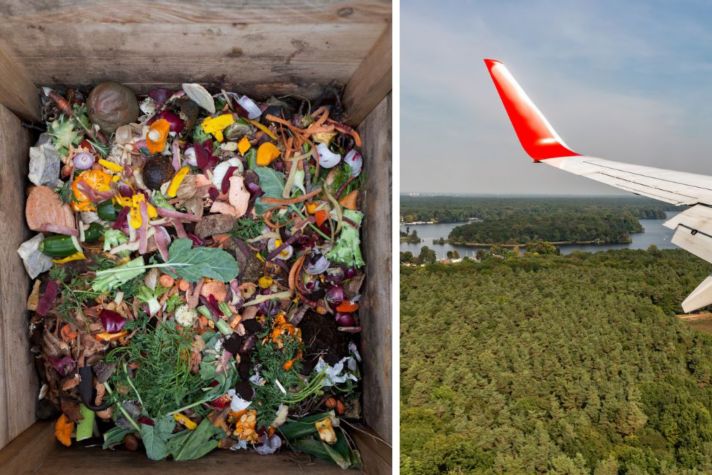-
 Global
Global-
Africa
-
Asia Pacific
-
Europe
-
Latin America
-
Middle East
-
North America
- |
- BUSINESSES
- |
- Contact
- |
-
 Global
Global-
Africa
-
Asia Pacific
-
Europe
-
Latin America
-
Middle East
-
North America
- |
- BUSINESSES
- |
- Contact
- |
You are browsing the product catalog for
- News
- Sustainable Aviation Fuel (SAF) Production: What’s Next
Sustainable Aviation Fuel (SAF) Production: What’s Next
New technology will make possible the conversion of ethanol into low-carbon jet fuel that is compatible with existing fueling infrastructure at airports.
In the transition from fossil fuels to clean, renewable energy, one of the hardest problems to solve is air travel. The first electric car was invented in the same century as the gas-powered vehicles we know today: the 1800s. And yet, in the 120-year history of aviation, electric flight is only now becoming possible.
That’s because fossil fuels are incredibly energy dense. Jet fuel stores 43 times more energy for its weight than today’s best batteries. But with carbon dioxide emissions from commercial aircraft set to triple by 2050, according to the International Council on Clean Transportation, the aviation industry will need technology to reduce its impact and become more sustainable.
One solution that excites airlines, airplane manufacturers and government regulators is sustainable aviation fuel (SAF). A low-carbon alternative to conventional, petroleum-based jet fuel, sustainable aviation fuel is made from renewable materials such as mustard seeds, sugar cane and used cooking oil.
How are renewable jet fuels made?
Traditional jet fuel is made from carbon-rich crude oil that is extracted from the ground. When it is burned in aircraft engines, that carbon is released into the atmosphere. Sustainable aviation fuel, however, is made from animal byproducts or agricultural waste, oils from plants and other biomass. When SAF is made from mustard seeds, for example, new mustard plants absorb and store the carbon molecules released in its combustion, making it renewable.
Over the life cycle of the fuel’s production and use, renewable fuels such as Honeywell Sustainable Aviation Fuel can lower carbon emissions up to 80%.
“Sustainable aviation fuel is one of the few pathways to decarbonizing flight today because it is a drop-in technology,” said Leigh Abrams, renewable fuels offering manager at Honeywell UOP. “You can use it in the existing fleet of airplanes without having to reconfigure the engines or change the fueling operations at the airport. And we know how to produce it today.”
Where is renewable jet fuel used?
Currently, aircraft can typically use a combination of up to 50% renewable jet fuel blended with traditional jet fuel from petroleum. But in December 2021, United Airlines marked a milestone by flying the first passenger flight powered by 100% SAF from Chicago to Washington, D.C.
The renewable jet fuel for that flight was produced using Honeywell’s EcofiningTM technology, which makes it possible to make sustainable aviation fuel from more feedstocks. As governments pass incentives to produce more renewable jet fuel or set targets for adoption, it will be crucial to produce SAF from more feedstocks to scale production.
“We’re aiming to produce sustainable fuels at the lowest overall cost,” Abrams said. “The lower the cost of renewable fuel, the easier we can make the transition to cleaner energy.”
Together, Honeywell and United Airlines have invested in Alder Fuels, a clean tech pioneer, to produce renewable jet fuel from low-cost feedstocks such as woody biomass waste, cornstalks and other crop waste.
When used together, the Alder technologies and Honeywell EcofiningTM are highly scalable — to meet the growing demand for sustainable aviation fuel — and could produce the first truly carbon-neutral jet fuel.
How will we make renewable jet fuel in the future?
The more abundant the feedstock and the more efficiently it can be converted to renewable jet fuel, the lower the cost — making the clean energy transition achievable for aviation.
As other industries make the energy transition, it opens new possibilities for more sustainable air travel. According to the U.S. Energy Information Administration, the United States alone currently produces about 15 billion gallons of ethanol fuel a year, mostly for use in cars. And as hybrid and electric vehicles replace traditional gasoline-powered cars, we may expect to see more and more surplus fuel ethanol capacity.
Building on our decade of EcofiningTM experience, Honeywell is developing a new ethanol-to-jet process to meet the growing demand for sustainable aviation fuel with ethanol that is already produced at mass scale. Honeywell’s ethanol-to-jet technology will convert ethanol (from corn, sugarcane, sorghum or other crops) into additional renewable jet fuel that is energy dense, stable, and compatible with existing fueling infrastructure at airports.
Turning ethanol, which we all see at the pump in daily life, into a low-carbon energy source for jets will help bring the benefits of sustainable aviation fuels to bear so that we can meet the energy challenges of the future.
“It is exciting to see the level of commitment from governments, airlines, passengers and businesses to decarbonizing aviation,” Abrams said. “We need more than one pathway to solve that problem, and our technology is evolving very quickly. We’re figuring out how to make mass air travel truly sustainable.”
Listen to this episode of "The Future Is..." podcast to learn more about our ethanol-to-jet technology and what it means for scaling SAF production.
Copyright © 2024 Honeywell International Inc.




